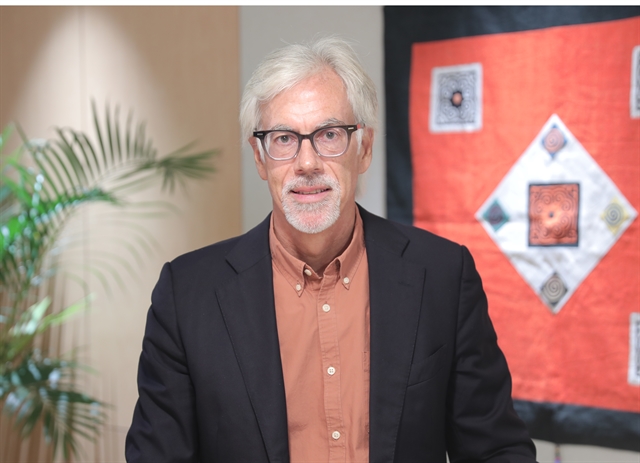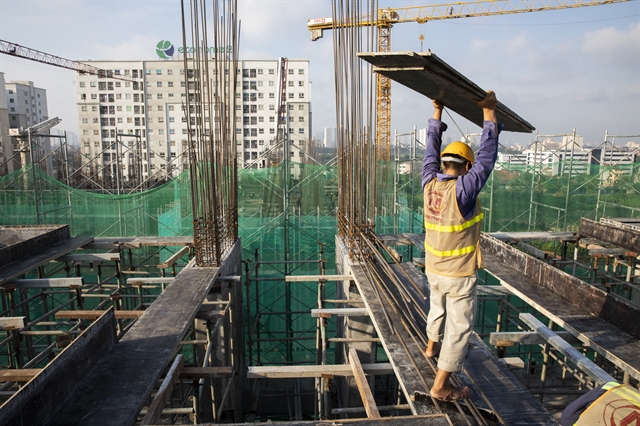 Economy
Economy

 |
| Thomas Jacobs, IFC's country manager for Việt Nam, Cambodia, and Laos. VNS Photo Mai Hương |
On October 13, Việt Nam celebrates the 20th anniversary of Entrepreneur's Day, marking the government's recognition of the private sector as crucial to the country's market economy. Việt Nam News, on this occasion, speaks with Thomas Jacobs, International Finance Corporation (IFC) country manager for Việt Nam, Cambodia, and Laos, about the private sector's role in Việt Nam's green transition.
How do you see the private sector's contribution to Việt Nam's economy over the past 20 years?
Firstly, congratulations to Việt Nam on this milestone. The last 20 years of entrepreneurship are a testament to the private sector's significant role in Việt Nam's economic growth. The private sector, supported by government policies, has played a remarkable part in this. While the private sector can do much, it also requires government backing through regulatory support and public investments.
Currently, about 45 per cent of Việt Nam’s GDP, 40 per cent of investment, and over 85 per cent of jobs are attributed to the private sector. Without it, Việt Nam wouldn’t have seen the economic development or the rising middle class that has emerged in the last two to three decades. The next key question is: what does Việt Nam do next?
As Việt Nam shifts towards a new growth model, what opportunities do you see in the green transition?
Yes, that's the crux of the matter. To achieve high-income status by 2045 and net-zero emissions by 2050, significant changes are needed. This starts with government reforms to create a conducive framework for the private sector. Việt Nam will need to balance its growth ambitions with sustainability goals, such as greening the economy and promoting a circular economy.
During my time here, I’ve seen strong alignment between the government and private sector on these goals. The question is not whether, but how, to achieve them. The energy transition is one key area, with demand expected to grow by about 8 per cent annually. Việt Nam must expand its electricity supply while making it greener, which will require new technologies and significant capital, much of which will come from abroad.
 |
| Construction of Ecohome 3, an EDGE-certified apartment complex developed by Capital House Group in Hà Nội. Currently, about 45 per cent of Việt Nam’s GDP, 40 per cent of investment, and over 85 per cent of jobs are attributed to the private sector. — Photo courtesy of IFC |
According to the World Bank and IFC's report, Việt Nam will need US$368 billion by 2040 to meet its growth and sustainability targets, with more than half coming from the private sector. Supportive government regulations will be essential to attract both domestic and foreign investment, particularly in power, transportation, green buildings, and energy efficiency.
It’s a massive opportunity, but it also presents risks. Standard Chartered reports that 78 per cent of overseas buyers would consider switching suppliers if they don’t meet sustainability objectives, posing a significant risk for economies that don’t adapt.
What are the challenges the private sector faces in adapting to the green economy, and how can they be addressed?
There are four main areas. First, the government needs to provide a strong legal and regulatory framework, along with public investment in infrastructure, particularly in energy and transport. For example, Việt Nam's power grid has weaknesses that require large-scale government action.
Second, access to finance is critical. While 80 per cent of domestic savings go through banks, less than 5 per cent of bank assets are in green investments. There's an opportunity for local banks to support green projects. IFC, with support from the Australian government, is working with SeABank, HDBank, and VPBank to drive this change.
Third, infrastructure, particularly in transport and power, is fundamental. Without modernising these systems, Việt Nam's growth will hit a wall, and the country will struggle to sustain manufacturing or attract FDI.
Fourth is skills development. Moving up the value chain from low-wage manufacturing to high-tech production requires a workforce with advanced skills. Việt Nam needs to equip its workforce with the ability to adapt to rapid global changes.
Addressing these areas—finance, government policy, infrastructure, and skills—will position Việt Nam for a successful transition.
Many Vietnamese companies are expanding globally. What strategies do you suggest for them to become significant global players?
A key factor driving these companies is their focus on environmental, social, and governance (ESG) standards. To compete globally, firms must meet rising ESG standards. International investors seek best-in-class firms that are on the right path, and Việt Nam has a unique opportunity here.
 |
| Workers making electronic components at Hanel P&T Vietnam. — Photo courtesy of IFC |
Vietnamese people are quick learners and highly capable, so it’s essential for companies to adopt sound ESG practices. Without these standards, it’s unlikely they’ll achieve large-scale success.
Another strategy is openness to foreign investment and new ideas. Many businesses in Việt Nam are still family-controlled, and transitioning to a more open structure can be challenging. However, bringing in partners, including foreign ones, can foster innovation.
Lastly, companies should measure success against global competitors, not just local ones. By setting ambitious goals and benchmarking themselves against firms in Malaysia, India, China, Europe, or the US, Vietnamese companies can achieve significant global success.
How can IFC further assist private enterprises in innovating and investing in sustainable practices?
IFC has already done quite a bit. Việt Nam ranks in the top 10 of IFC’s global portfolios, with over $2 billion in exposure. Last year, we invested around $750 million, 60 per cent of which was green.
Our strategy is to drive private sector investment in sustainability and the green transition. This includes blue and green bonds, supporting green supply chains, and decarbonising manufacturers. We're also working with the State Securities Commission on ESG standards for listed companies and supporting individual green investments. VNS




